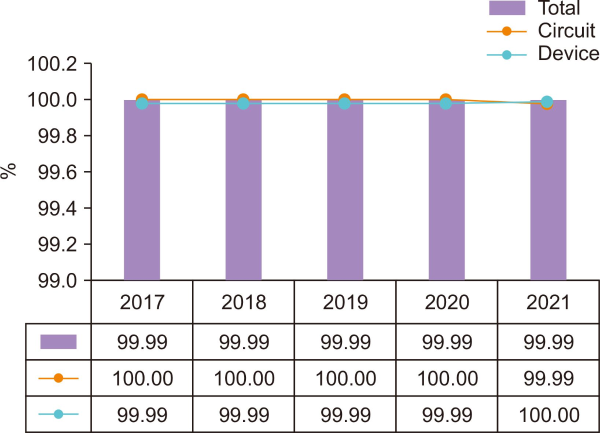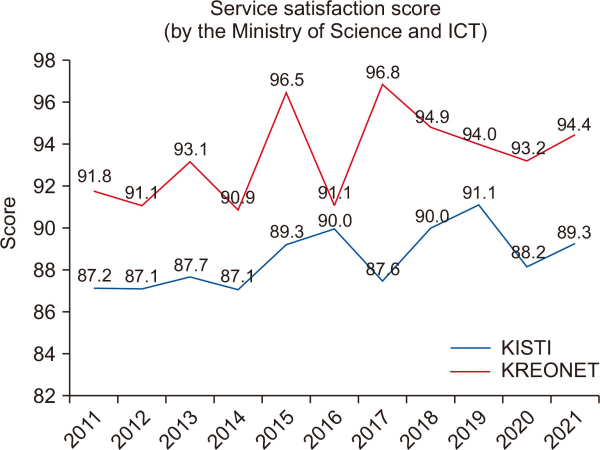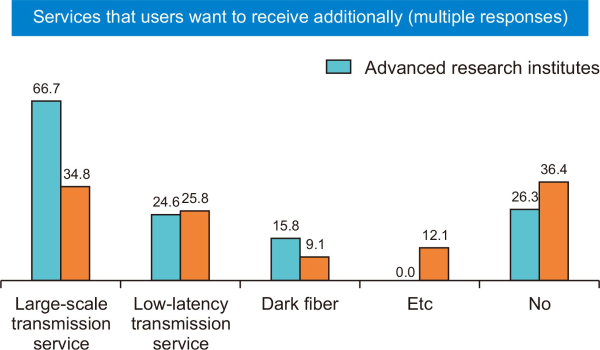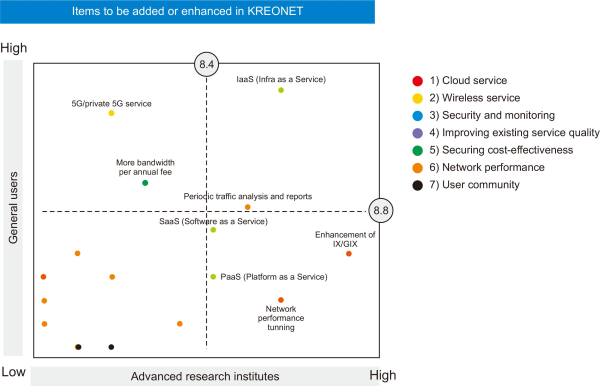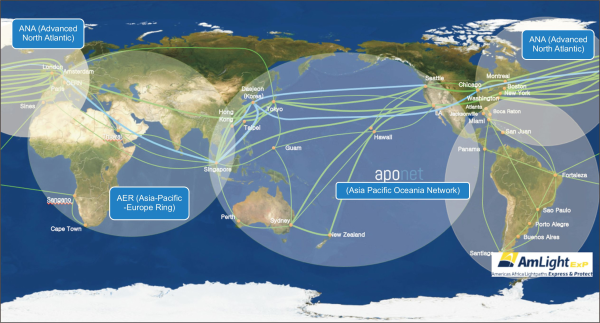1. INTRODUCTION
The National Research & Education Network (NREN) is a special network provider that builds and operates networks aimed at supporting the research and education communities in their countries. Unlike commercial networks for general users, NREN provides a high-speed backbone network to support education and research fields. In addition, it provides various network services such as ID federation and security, and leads research and development of next-generation network technologies. Currently, most major countries are operating NREN, and by continent, there are Internet2/ESnet in North America, GEATN/SURF in Europe, AARnet in Oceania, and KREONET/SINET/CERNET in Asia. In addition, there are a number of national NRENs. In 1985, the National Science Foundation Network (NSFNET) was launched with the support of the National Science Foundation (NSF) for the purpose of efficiently utilizing high-performance computing resources in the United States. It can be seen as the beginning of NREN. Recently, the importance of NREN is increasing due to a surge in demand for collaborative research using large-capacity data in various scientific research fields such as High-Energy Physics (HEPs), astronomy and space, biology, and climate science. In addition, the un-tact transition due to COVID-19 and the continuous increase in demand for cloud services are also demanding more roles from NREN.
KREONET was launched in 1988 and started the first TCP/IP-based Internet service in Korea. Currently, we are building and operating a backbone infrastructure with a transmission speed of 100 Gbps per single lambda, and more than 200 institutions in the information and communication technology (ICT) field such as research institutes and universities are linked. In 2004, it started to build and operate an international network through the GLORIAD project. KREONET is contributing to the creation of scientific and technological achievements by supporting domestic and global research. In addition, it provides next-generation network technology and user services such as a Software Defined Network (SDN) testbed, Quantum Key Distribution (QKD), Trust and Identity (T&I) service, and ScienceDMZ.
The structure of this paper is as follows. Section 2 compares and analyzes the footsteps of NREN in the 2000s, 2010s, and present by classifying them into network infrastructure, network services, and next-generation network technologies. Sections 3 and 4 analyze KREONET’s achievement and future demand analysis, respectively. Section 5 presents the future strategy of KREONET based on the results of the KREONET achievement and future demand analysis.
2. NREN FOOTPRINTS AND STRATEGIES
This section summarizes the footsteps and strategies of NREN through data including the TERENA/GEANT Compendium, an annual European NREN report based on a survey (Allred & van Pinxteren, 2016; Buscaglione et al., 2021; van Pinxteren, 2005, 2010). This paper describes the history of NREN by categorizing it into the 2000s, 2010s, and the present. In addition, we classified the three main themes: network infrastructure, network service, and next-generation technology. Table 1 summarizes the footsteps and strategies of NREN by three themes and eras.
2.1. Network Infrastructure
From the perspective of network infrastructure, the status of NRENs in major countries is surveyed. In the 2000s, the transmission rate of NREN’s backbone core network was mainly 10 Gbps per lambda, and the maximum transmission rate was 40 Gbps per lambda. In addition, NRENs in major countries have steadily secured dark fiber that is not currently in use but can be used in the future by utilizing IRU (Indefeasible Rights of Use), a long-term rental contract method. In the 2010s, NRENs in major countries upgraded their backbone networks to 100 Gbps per single lambda. Recently, NRENs in major countries are pushing for backbone upgrades of 400 Gbps per single lambda.
2.2. Network Service
We compare and analyze the strategies of NRENs in major countries in terms of network services. In the 2000s, there was a demand for an ID federation and authentication system in which NREN users could conveniently and safely use multiple services with the same ID regardless of access location. Accordingly, NREN established and developed the Authentication and Authorization Infrastructure (AAI), international certification standards, and tools. In addition, wireless network-based eduroam service was provided so that users can use the service anywhere in the world. In the 2010s, NRENs provided services that ensure reliable high-capacity data transmission along with 100G-based core network upgrades. For this purpose, traffic monitoring tools such as looking glass, ping, traceroute, ASpath, and PerfSonar are provided to users to ensure performance. In addition, services such as L2/L3 Virtual Private Network (VPN) and Distributed Denial of Service (DDoS) mitigation are provided to ensure transmission performance and to cope with security issues. The services introduced above are still being provided to users as core services of NRENs and are being upgraded to meet user needs. From the perspective of T&I, the identity provider (IdP) and service provider (SP) are being expanded, and services are being upgraded through security enhancement such as multi-factor authentication (MFA). In terms of security, services such as DDoS mitigation and firewall on demand (FoD) are provided. In addition, policies are being considered that deal with private information, such as Europe’s General Data Protection Regulation (GDPR), and communities are operated to cope with advanced security threats. Lastly, NREN is building an infrastructure and data exchange platform by directly interworking with data centers as users’ demand for cloud services increases.
2.3. Next Generation Technology
We compare and analyze the status of NRENs in major countries from the perspective of next-generation network technology. In the 2000s, demand for grid computing, a technology that can efficiently utilize distributed computing resources, arose. For this reason, NRENs provided grid service that provides infrastructure and community for scientific research purposes. In addition, NRENs provided services for IPv6 in preparation for depletion of IP address resources. In the 2010s, SDN / Network Function Virtualization (NFV) was introduced as the next-generation network technology. Openflow has been accepted as a de facto standard for the data plane, and various platforms have been proposed as the controller plane for generating flow rules and managing higher-level applications. Recently, technologies for automation and intelligence have been applied from the network operation point of view and the service point of view. As P4-based network equipment is developed to a commercial level, it is possible to overcome vendor-dependent limitations and apply various applications. As a typical application, In-band Network Telemetry (INT), which can monitor packet-level real-time traffic, can accurately analyze the network environment in real time. These technologies will play the role of core technologies that enable artificial intelligence (AI)-based network automation and intelligence.
3. KREONET ACHIVEMENTS
In this section, the achievements of KREONET as a NREN are categorized and organized into advanced scientific research support, backbone operation, and service. KREONET classifies the field of advanced science into ten groups and provides and supports networks suitable for the characteristics of each field. Fig. 1 shows the fields of advanced scientific research that actively utilizes KREONET. Representative scientific research achievements contributed by KREONET include Higgs particle discovery research by the CERN Large Hadron Collider (LHC) in 2013, gravitational wave detection by the Laser Interferometer Gravitational-Wave Observatory (LIGO) in 2017, and M87 black hole observation by the Event Horizon Telescope (EHT) and Korean VLBI Network (KVN) in 2019. In addition, research on artificial sun and nuclear fusion energy using Korea Superconducting Tokamak Advanced Research (KSTAR) KSTAR and International Thermonuclear Experimental Reactor (ITER), next-generation radio telescope research using Square Kilometre Array (SKA) and Large Survey Telescope (LSST), and intercontinental light clock research using very-long-baseline interferometry (VLBI) are also research fields that can expect scientific results.

Field of advanced scientific research. LHC, Large Hadron Collider; LIGO, Laser Interferometer Gravitational-Wave Observatory; EHT, Event Horizon Telescope; KVN, Korean VLBI Network; KSTAR, Korea Superconducting Tokamak Advanced Research.
In addition, there are papers using KREONET as an indicator of KREONET’s support for advanced research. As shown in Fig. 2, from 2019 to 2021, the number of papers is continuously increasing. The number of Science Citation Index (SCI)-level papers published by the first author or the corresponding author is 225, and the number of SCI-level papers published by the second author or less was 735 in 2021.
From the point of view of backbone infrastructure, KREONET upgraded the backbone infrastructure to 100G-class based on a single lambda in 2015, and is currently in the process of upgrading, including the building of the 400G-class backbone core by reflecting user demand. In addition, the network is monitored 24 hours a day, 365 days a year, and in case of failure, a manual is prepared for each situation at all times. Through this, as shown in Fig. 3, the annual KREONET service availability rate of 99.99% or more is continuously achieved, providing commercial-level service.
KREONET provides various services to support users’ network utilization and research activities. Representatively, the Korean Access Federation (KAFE) is operated as a T&I service for ID federation. Currently, there are 26 IdPs, which are ID providers of KAFE, and 60 SPs, which are service providers. In addition, KREONET is providing video conferencing services, which have been in explosive demand due to COVID-19, as well as data transfer node (DTN), a large-capacity data transmission service, and network security services. Fig. 4 shows the annual service satisfaction results of KREONET and its upper organization, KISTI, in a survey conducted by the Ministry of Science and ICT. KREONET has recorded high user satisfaction of over 90 points for over ten years.
4. ANALYSIS OF KREONET FUTURE DEMAND
This section analyzes future demand from the point of view of KREONET’s network resources and services, and explains the upgrade plan based on the analysis results. For this purpose, this paper utilizes a report on KREONET future demand and value analysis based on a survey conducted by the Korea Research International (KRI) Incorporation. The survey was conducted from June 16 to July 8, 2021. In addition, the survey respondents were classified into advanced research institutes, general users, and potential users. Potential users did not currently use KREONET, but participated in the survey as a group with potential for future use. In detail, the survey was conducted with researchers at 85 cutting-edge research institutes with more than five years of experience, and users and computer managers at 116 KREONET general member institutes. KRI’s investigation was conducted in a web-based online manner due to COVID-19. After collecting survey response data, data processing and statistical analysis were performed based on it.
Fig. 5 is a graph showing the annual traffic volume and bandwidth demand from 2021 to 2025 based on a survey on the domestic networks of advanced research institutes and potential users. Annual traffic volume is expected to grow by 74% annually, from 146TB in 2021 to 1,335TB in 2025. The bandwidth demand increases by 45% annually, and 7,228 Gbps is required in 2025 compared to the currently used bandwidth of 1,630 Gbps. In particular, bandwidth demand in 2022 is expected to increase by 189% compared to the previous year’s 1,630 Gbps to 4,714 Gbps. Through this, it is analyzed that research that requires large-capacity data transmission by advanced research institutes will increase rapidly from 2022. Therefore, KREONET needs a preemptive network upgrade in preparation for such an increase in traffic and bandwidth demand. Currently, KREONET is in the process of upgrading the backbone of domestic and international networks to reflect these future demands.
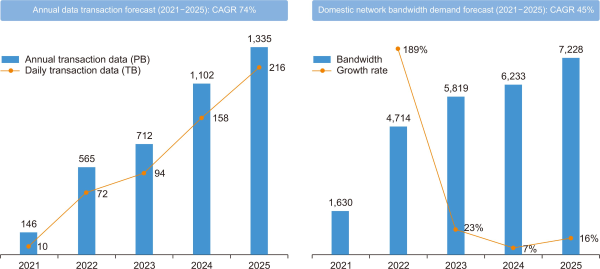
Annual traffic volume and bandwidth demand on domestic network of KREONET. CAGR, compound annual growth rate.
Fig. 6 compares the bandwidth demand and annual growth rate of domestic networks by research field in 2025. It can be seen that astronomy and HEP fields, which currently use the most bandwidth, will also require high bandwidth in the future. This is because the domestic research demand in this field is steadily rising. In the field of astronomy and space, ultra-high-speed/ultra-wideband transmission is required due to observation and operation and data transmission of KVN. In the HEP field, high-speed/ultra-wideband transmission is required for experiments and high-capacity data transmission using KSTAR of the Korea Institute of Fusion Energy (KFE). In addition, Fig. 6 shows that DNA (Data/Network/AI) is a research field that does not require a large amount of bandwidth at present, but requires a large amount of bandwidth in the future. The DNA field shows an annual increase in bandwidth demand of more than 160%. DNA is an area that is also in line with the current national policy of the ultra-high performance computing innovation strategy, which is scheduled for large-scale investment in building infrastructure at the national level. Therefore, it can be interpreted as a result reflecting the demand for network infrastructure for ultra-high-speed/broadband transmission between ultra-high-performance computing resources.
Fig. 7 compares the domestic network bandwidth demand and annual growth rate by region as of 2025. As shown in the figure, it can be seen that Daejeon and Seoul have the highest bandwidth demand. Daejeon-Seoul is the core link of the KREONET backbone, and is currently pursuing an upgrade that guarantees a transmission speed of 400G per single lambda. In addition, the KREONET network upgrade will focus on regional centers that reflect the results of regional bandwidth demand forecasts.
Fig. 8 shows the results of surveying the bandwidth demand of international networks from 2021 to 2025 for high-tech research institutes and potential users. For international networks, bandwidth demand is expected to increase by 70% annually, from the currently used bandwidth of 233 Gbps to 2,044 Gbps by 2025. It can be seen that the demand for international network bandwidth, like the domestic network, has increased more than seven times from 233 Gbps in 2021 to 1,661 Gbps in 2022. Therefore, KREONET’s international network is also scheduled to be upgraded to reflect this demand.
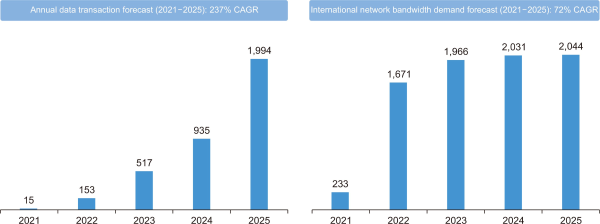
Annual traffic volume and bandwidth demand on international network of KREONET. CAGR, compound annual growth rate.
Fig. 9 shows the international network bandwidth demand and growth rate by region as of 2025. North America and Europe, which account for a large portion of the current bandwidth, will also have the highest bandwidth demand in 2025. Fig. 9 shows high bandwidth demand growth rate in South America and Oceania, where the existing bandwidth is low. This can be interpreted as a result of reflecting the demand for large-scale research projects including LSST and SKA in the field of astronomy and space.

International network bandwidth demand and annual growth rate by region in 2025. CAGR, compound annual growth rate.
The service items requested to be provided by KREONET in the future are high-capacity transmission service, low-delay transmission service, and dark fiber for both advanced researchers and general users, as shown in Fig. 10. These results are interpreted as the greatest demand for the basic role as a NREN to transmit large-capacity data within a desired time. Dark fiber has the potential to increase bandwidth at a desired time, but it is also a result of reflecting the demand for applied research using dark fiber. The dark fiber-related research that KREONET is conducting includes the development and testing of QKD equipment, and precise time synchronization using the Optical Clock of the Korea Research Institute of Standards and Science (KRISS).
Fig. 11 shows the results of detailed items requested by advanced research institutes and general users to be added or strengthened. The most demanding items for advanced research and general users are Infrastructure as a Service (IaaS), that is, cloud service. Many researchers who utilize KREONET have increased demands on the infrastructure and services of the cloud. In addition, requests for periodic network traffic analysis and reporting were also high for both advanced research institutes and general users. In addition, advanced research institutes had a high demand for interworking with domestic and international Internet exchanges (IXs), and requests for wireless services such as 5G were high from general users.
5. FUTURE STRATEGY OF KREONET
NREN provides high-performance networking services through advanced networking in fields such as national basic and applied science and education that are distinct from commercial networks. It aims to improve national science and technology competitiveness as well as scientific discovery, and it is continuously growing. In particular, Data Intensive Science, which has been widely used as a new scientific paradigm, is accelerating even more than after it first appeared in the early 2010s. The present and future are truly the era of data flooding. CERN Hi-Luminosity LHC’s large experimental equipment-based HEPs field, the artificial sun (KSTAR, ITER project)-based nuclear fusion energy field, the astronomical space field based on giant radio telescopes such as SKA and LSST, and bio fields such as vaccine development are representative data-intensive science fields. As a result, collaborative research for new scientific discovery or innovative scientific technology development is increasing in the field of large science in which domestic as well as global researchers participate together. In order to keep pace with the demands of giant science, it is necessary to establish a preemptive research network backbone based on future demand and an efficient and active network operation and management system. In addition, the government established a Korean New Deal plan (‘20.7) to respond to the Fourth Industrial Revolution and promotes the convergence and utilization of NREN-based DNA (Data, Network, AI) infrastructure. Therefore, it is necessary for KREONET to develop T&I networking technology, including a digital research collaboration environment, and secure a service system. Accordingly, the future development strategy for KREONET in three aspects of research network infrastructure, service, and technology development is as follows.
In the case of domestic research network infrastructure, NRENs in major overseas countries such as North America (Internet2/ESnet), Europe (GEANT/SURFnet), Oceania (AARnet), and Asia (SINET) are currently pushing for an update with a transmission rate of 400 Gbps or more per single wavelength. Also, in the case of global research networks, 100 Gbps transmission speed per single wavelength is mainly used in submarine cables, but it is expected to gradually change to 400 Gbps transmission speed. In addition, as shown in Fig. 12, a large consortium for each continent/ocean has been formed to establish a mutual backup system for each country’s international research network and to continuously promote joint use. The movement of these national and global research networks is expected to continue to be advanced in order to meet the transmission speed requirements of 100 Gbps or higher required in the global science field. Accordingly, KREONET not only has a transmission speed of 400 Gbps-800 Gbps or more between Seoul and Daejeon, but also participates in an international research network consortium covering Asia-Pacific, Asia-Europe, and North America-Europe, so that domestic researchers can participate in large scientific research. In addition, the establishment and cooperation of domestic and international infrastructure that can play a leading role in relevant research fields is of utmost importance.
In the case of NREN services, as the demand for performance-guaranteed high-performance networking services such as L2VPN and L3VPN, including traditional IPv4/IPv6-based Internet services, is expected to continue to increase, the service needs to be further strengthened. In particular, Internet traffic is increasing due to applications such as video conferencing and online education due to COVID-19. In addition, since the traffic to the data center of content providers or cloud providers accounts for more than 56% of the total traffic (Cantor, 2022), it is necessary to strengthen the interworking service to the data center.
In addition, the demand for T&I services that can significantly improve access to various science and technology application services is increasing. Accordingly, NRENs in most major foreign countries have their own T&I institutions that provide multiple ID federation services to multiple ID providers. As a service associated with T&I, video conferencing services considering non-face-to-face environments, storage services for global collaborative research, large-capacity file transfer services, and cloud services are continuously increasing, so it is necessary to respond. In particular, with the explosive increase of scientific data, the demand for storage services is increasing, and integration and automation of storage resource allocation services along with the existing network resource allocation services are required.
Technological development for QKD is required due to the demand for secure network service. Development of network-type QKD service through key management system (KMS) is required from the existing short-distance end-to-end service. Of course, quantum communication that can transmit the state of qubits in the future quantum computer era also requires the establishment of a long development roadmap. In addition to existing data transmission, it is necessary to transmit optical frequency/time information through an optical cable for redefining seconds that overcome the limitations of space-time measurement. In addition, it is necessary to prepare for the precise frequency synchronization and time services required by 5G/6G, autonomous vehicles, and future energy of the Fourth Industrial Revolution.


